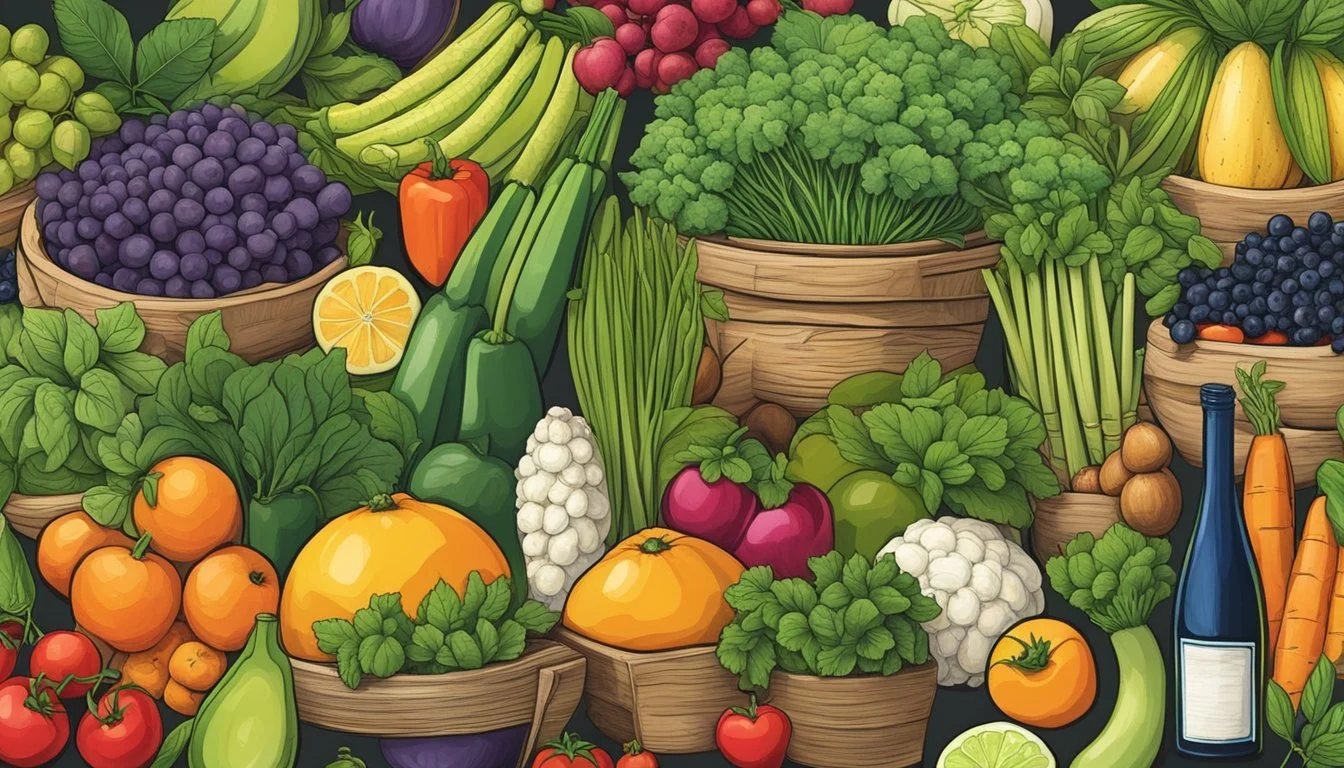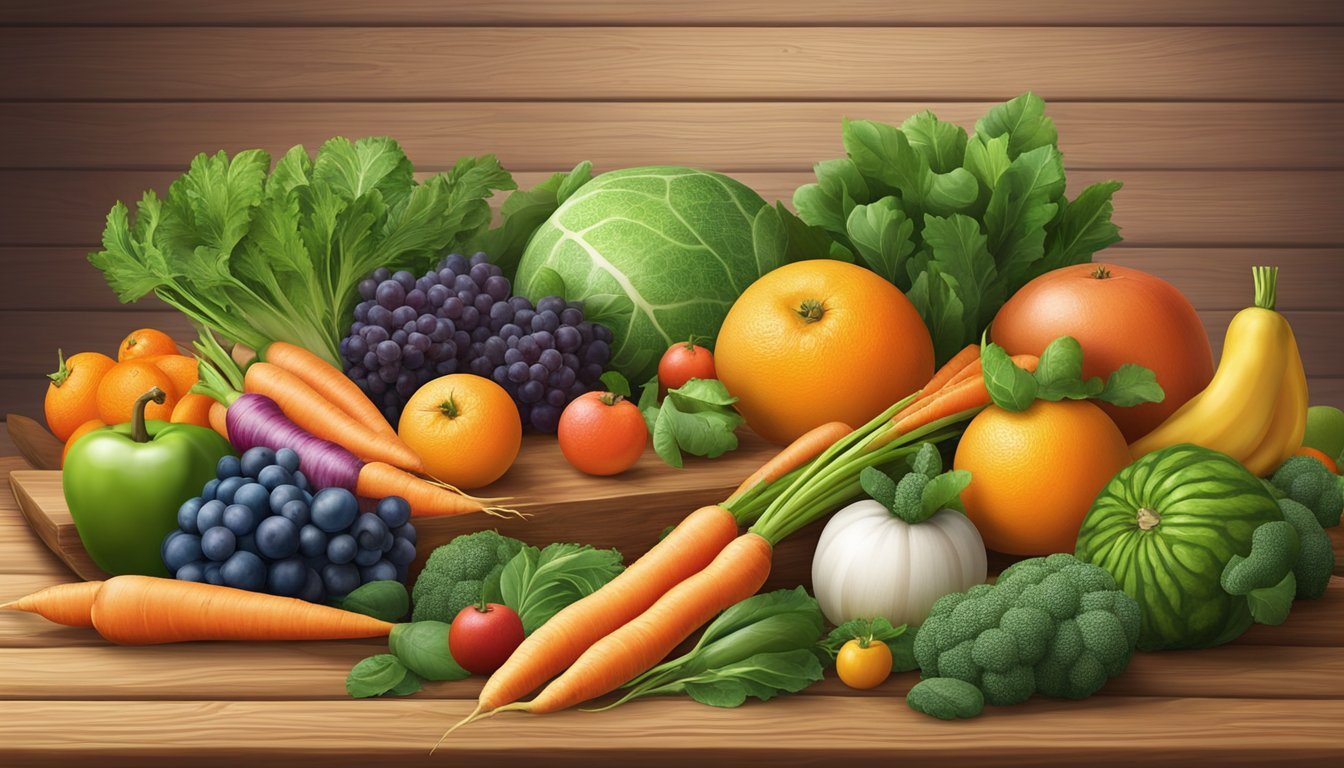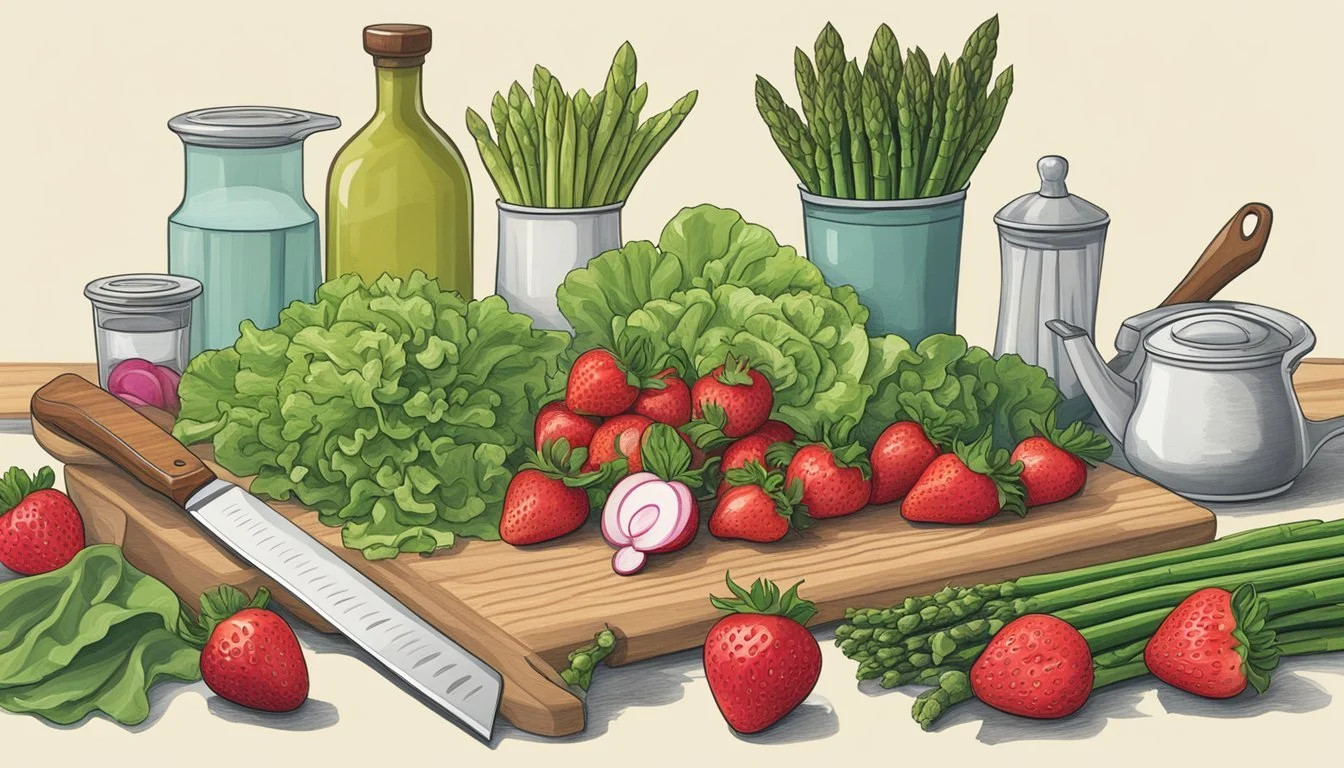Kentucky Seasonal Fruit & Vegetables in March
Your Fresh Picks Guide
This Article is Part of our Kentucky Seasonal Fruit & Veg Calendar
March in Kentucky marks a transition from the dormant winter to early signs of spring, as the climate begins to warm and a new growing season takes its tentative first steps. This is a time when farmers and gardeners prepare for the upcoming abundance, and early seasonal produce starts to make its way to market stands and grocery store shelves.
While the selection of fresh produce in March is not as vast as it might be in the high growing season, Kentucky still offers a variety of fruits and vegetables. Root vegetables like radishes and turnips, which have been stored from winter or are some of the earliest crops to be harvested in spring, are typically available. Hardy leafy greens such as spinach and kale (What wine goes well with kale?) can also be found, their cold tolerance allowing them to be one of the first fresh offerings of the year.
As the state looks forward to the larger harvests of late spring and summer, residents and chefs alike make the most of the March offerings, incorporating these seasonal ingredients into their cuisine. Stored apples from the previous fall might still be found and utilized, and the promise of increasingly diverse and fresh options hints at the bounty that warmer months will soon bring.
Seasonal Overview
March marks the transition from the cold, barren winter to the budding warmth of spring in Kentucky. This is a critical time for fresh produce, as certain winter crops are reaching their end and spring varieties begin to emerge.
Seasonal Shifts
In Kentucky, March is characterized by a gradual shift in season as winter produce makes way for the first signs of spring. Winter crops such as kale and carrots are still available early in the month, while spring ushers in a variety of leafy greens. Farmers prepare for an influx of seasonal produce that thrives in the milder temperatures, including:
Leafy Greens: Including mustard greens, spinach, and lettuce, which begin to peak in freshness.
Cruciferous Vegetables: Such as cabbage, which remain in good supply from winter.
Root Vegetables: Like radishes, start to appear in the later part of the month.
It's the time of the year when cold-hardy citrus fruits are at the tail end of their season, while early spring crops start to become more prominent.
Significance of Seasonal Eating
Seasonal eating in March is important both for nutritional value and for supporting local agriculture. Eating seasonally ensures that one consumes produce at its peak in both taste and nutritional content. For instance, leafy greens consumed in season may offer more vitamins and minerals than those harvested off-peak. In addition, sourcing in-season produce locally reduces transportation and storage time, allowing consumers to enjoy produce that retains more natural flavors. Furthermore, embracing seasonal eating can help in reducing the carbon footprint, as it typically involves less transportation and processing compared to non-seasonal foods, which can contribute to a healthier environment.
Fruits in Season
March in Kentucky brings the beginning of spring and with it, the early offerings of the region's fruit harvest. This transitional period typically sees the last of the winter fruits and the emergence of spring's first fresh picks.
Citrus Fruits
Citrus fruits are winding down from their peak winter season, yet they still remain available in March. Shoppers can find oranges and grapefruits during this time, with their zesty flavors adding a refreshing note to the lingering chill of early spring.
Tree Fruits
Early varieties of apples may still be in markets, though the prime apple season has passed. Kentuckians might also find the last of the pears remaining from the fall harvest in select locations, signaling the close of their season.
Berries
Berry season is just about to begin, with the first strawberries often making an appearance towards the end of the month. They mark the onset of the berry season, which will soon include blackberries, blueberries, cherries, and raspberries as the warmer months approach.
Vegetables in Season
In Kentucky, March marks the transition from winter to spring, bringing a variety of seasonal vegetables to the forefront. Farmers and gardeners begin to harvest both cool and warming weather crops, offering a unique blend of flavors and nutritional benefits.
Leafy Greens
Kentucky's fields in March are abundant with leafy greens. Spinach and kale emerge as staples, offering versatility for both raw and cooked applications. These greens are packed with vitamins and are a perfect addition to spring dishes.
Spinach: High in iron and vitamins A and C
Kale: Rich in vitamin K and antioxidants
Root Vegetables
Despite the warming weather, root vegetables remain an excellent choice. Radishes and turnips are commonly found during this period. Their crisp texture and earthy flavors are excellent for salads or as a complement to any meal.
Radishes: Offer a peppery bite and are great for digestive health
Turnips: Can be mashed or roasted, delivering a mild, slightly sweet taste
Cruciferous Vegetables
Cruciferous vegetables like broccoli (how long does broccoli last?) and cabbage continue to be in season. They thrive in the cooler temperatures early in the month, and both are renowned for their health benefits and versatility in dishes from salads to stir-fries.
Broccoli: Contains high levels of fiber and vitamin C
Cabbage: Perfect for slaws or fermented to make sauerkraut (how long does sauerkraut last?)
Alliums
Members of the allium family such as leeks and garlic are also ready for harvest in March. These vegetables add depth and aroma to a variety of culinary creations, whether they're used as base flavors in soups and stews or featured more prominently in a dish.
Garlic: A staple in most kitchens, enhances flavor and has medicinal properties
Leeks: Provide a milder, sweeter alternative to onions
Herbs & Flavor Enhancement
Bringing vibrant flavors to the plate, herbs, as well as alliums and roots, are key ingredients in the culinary world. In Kentucky, the climate and soil allow for a selection of these to be accessible even in early spring, like March.
Herbs
In March, Kentucky gardeners and consumers often have access to a variety of fresh herbs (how long do fresh herbs last?) which can enhance any dish with their fresh flavors. Arugula, (how long does arugula last?) with its peppery taste, is a standout herb during this time. Though commonly treated as a leafy vegetable, arugula is a flavorful herb that can be used in salads, as a garnish, or for adding greenery to sandwiches.
Alliums & Roots for Flavor
Alliums such as onions and garlic, though not at their peak harvest, can be stored from previous harvests and are available for use in March to add depth and intensity to meals. Roots like ginger can also be found, offering their earthy and pungent notes. Olive oil is not locally produced, but it is a pantry staple that serves as an excellent base for dressings and for cooking, complementing the flavors of fresh herbs and alliums.
Nutritional Information
Selecting fresh, in-season produce provides enhanced flavor, quality, and a myriad of nutritional benefits. March’s seasonal offerings in Kentucky, for instance, include a range of fruits and vegetables that are dense in essential nutrients.
Benefits of Fresh Produce
The benefits of consuming fresh produce in March are significant due to the high content of vitamins, minerals, and other beneficial compounds. Here is a breakdown of some key nutritional components found in various fruits and vegetables that are in season during this month:
Vitamin C: Often found in citrus fruits, vitamin C is crucial for the maintenance of healthy skin, blood vessels, bones, and cartilage. It also supports the immune system.
Calcium: Leafy greens such as kale and broccoli, which are abundant in March, offer calcium that is important for strong bones and teeth as well as muscle function.
Other Nutrients:
Fiber: Found in apples, pears, and root vegetables like carrots, fiber aids in digestion and can help regulate blood sugar levels.
Potassium: Bananas and sweet potatoes, both available in March, provide potassium, which is vital for heart and muscle function.
Antioxidants: Many fruits and vegetables, like strawberries and Brussels sprouts, contain antioxidants that protect the body's cells from damage.
Consuming a variety of these nutrient-rich foods supports overall nutrition and health. Each fruit and vegetable brings its own set of nutritional advantages, from bolstering the immune system to supporting bone health.
Preparation & Recipes
March in Kentucky brings a variety of fresh produce to the table. The key to maximizing flavor and nutrition is to utilize simple preparation methods and incorporate these ingredients into vibrant seasonal recipes.
Simple Preparations
Steaming is a gentle way to cook vegetables while preserving their color and nutrients. For example, fresh asparagus (What wine goes well with asparagus?), which is in season during March, can be quickly steamed until it is vibrant green and tender-crisp. This method highlights the vegetable's natural flavors without the need for heavy seasonings or sauces.
Asparagus: Trim the ends, steam for 3-5 minutes.
Broccoli: Cut into florets, steam for about 5 minutes.
Seasonal Recipes
Each seasonal ingredient can be transformed into a delightful dish with the right recipe. Here are some specific ideas that elevate March's bounty:
Oven-Roasted Asparagus: Toss asparagus with olive oil and sea salt (how long does sea salt last?), roast in a preheated oven at 400°F for 15 minutes.
Broccoli and Cheese Soup: Start with sautéed onions, then add steamed broccoli, broth, and a touch of cream for richness. Puree until smooth and finish with a generous helping of shredded cheese.
Shopping Local
When shopping for seasonal produce in Kentucky during March, one can find a variety of fresh and organic options. Local markets and community-supported agriculture programs are ideal for consumers seeking nutrient-rich and flavorful fruits and vegetables.
Farmers' Markets
Farmers' markets are a treasure trove of local produce, often providing a wide selection of fresh, organic fruits and vegetables. Shoppers at these markets are supporting Kentucky farmers and the local economy. For instance, the Douglass Loop Farmers Market, open every Sunday from March to December in Louisville, offers an array of seasonal goods.
Location: 2005 Douglass Blvd., Louisville, KY
Hours: Sundays, 10am - 2pm
Community-Supported Agriculture (CSA)
Community-supported agriculture programs allow individuals to subscribe and receive a share of the season's harvest directly from local farms. CSAs are beneficial for those who value not only freshness but also organic farming practices. Subscribers often get a variety of what's currently in harvest, which can include a range of leafy greens, root vegetables, and early spring fruits. Through CSAs, consumers directly support their farming community and often foster a deeper connection to their food sources.
Benefits: Fresh, organic produce; supports local farmers; fosters community connection
Monthly Produce Calendar
March in Kentucky ushers in the early start of spring, bringing fresh produce to local markets and grocery stores' departments. Here one can find a curated list of fruits and vegetables that are typically in season during this month.
Fruits
Apples: Though not in their peak season, stored apples from previous harvests are still available.
Strawberries: Occasionally start to emerge at the end of the month.
Vegetables
Greens: Including kale, spinach, and lettuces, are abundantly in season.
Root vegetables: Such as parsnips, continue from their winter availability but might wane as the month ends.
Radishes: Begin to make their appearance in local produce sections.
Asparagus: May begin to show up in the latter part, marking the onset of its season.
It is important to note that weather patterns and regional climate variations can affect the exact timing of produce availability. Shoppers are encouraged to seek out local Kentucky farmers' markets for the freshest selection and to support local agriculture. The presented items reflect typical seasonal patterns for March and offer the freshest options for consumers seeking to purchase produce at its peak.









